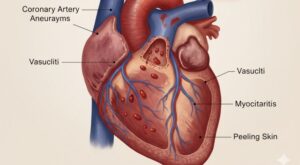Understanding ADHD in Children and Adults: A Guide for Families, Teachers, and Caregivers

Imagine a brain that’s constantly buzzing with thoughts—racing ideas, shifting focus, heightened energy, but also deep frustration. That’s what life can feel like for someone with Attention-Deficit/Hyperactivity Disorder (ADHD).
Often misunderstood, ADHD is not a character flaw, a result of poor parenting, or “just a phase.” It’s a neurodevelopmental condition that affects both children and adults, impacting attention, impulse control, and executive function.
Let’s demystify ADHD with compassion and science—and learn how to support those living with it.
What Is ADHD?
ADHD is a brain-based condition characterized by inattention, hyperactivity, and/or impulsivity that interferes with daily functioning or development. It’s one of the most common neurodevelopmental disorders in children and often persists into adulthood.
According to the CDC, around 5–10% of children and 4.4% of adults worldwide are affected by ADHD[1]. It’s not just a childhood disorder—many adults struggle silently for years without diagnosis.
ADHD in Children: What It Looks Like
Every child is active and distractible sometimes. But children with ADHD show symptoms that are:
- Persistent (lasting over 6 months),
- Pervasive (occurring across settings—home, school, etc.),
- Problematic (causing significant disruption).
Common Signs:
- Difficulty focusing or completing tasks
- Easily distracted or forgetful
- Excessive talking or interrupting others
- Fidgeting, restlessness
- Trouble waiting turns or following instructions
- Emotional outbursts or mood swings
Note: ADHD can look different in girls—often presenting as daydreaming, anxiety, or low self-esteem rather than hyperactivity.
ADHD in Adults: Often Hidden, Always Impactful
Many adults with ADHD were never diagnosed in childhood. They may experience:
- Chronic disorganization and poor time management
- Restlessness or inability to relax
- Frequent job changes or relationship difficulties
- Trouble starting or completing tasks
- Emotional regulation issues (irritability, frustration)
For adults, untreated ADHD can increase the risk of depression, anxiety, substance abuse, and even financial instability. But the good news? It’s manageable—with the right support.
What Causes ADHD?
ADHD is biological, not behavioral. Research points to:
- Genetic factors – It often runs in families
- Brain structure/function – Differences in dopamine pathways and delayed maturation of certain brain regions
- Prenatal/environmental risks – Exposure to toxins, maternal smoking, low birth weight
It’s not caused by sugar, screen time, or “bad parenting,” though these can worsen symptoms.
Diagnosis: Science + Context
There’s no single test for ADHD. Diagnosis involves:
- A detailed clinical history
- Observations from multiple settings (school, home, work)
- Standardized behavior rating scales
- Ruling out other medical or psychological conditions (e.g., anxiety, learning disorders)
In India, many cases go undiagnosed due to stigma, lack of awareness, or access to specialists. Normalizing conversations around ADHD is crucial.
Treatment & Management: A Multi-Pronged Approach
1. Behavioral Therapy
Especially effective for children under 6. Parents are trained to use consistent structure, positive reinforcement, and coping strategies.
2. Medication
Stimulants (like methylphenidate) and non-stimulants (like atomoxetine) can be life-changing when appropriately prescribed. They help regulate neurotransmitters and improve focus, self-control, and daily functioning.
3. Cognitive Behavioral Therapy (CBT)
Useful for teens and adults—CBT helps with emotional regulation, time management, and reframing negative thinking patterns.
4. Lifestyle Modifications
- Sleep hygiene
- Regular physical activity
- Nutrition (protein-rich meals may aid concentration)
- Mindfulness or yoga practices
- Reducing digital distractions
5. Academic and Workplace Support
- Individualized Education Plans (IEPs) in schools
- Flexible deadlines or work-from-home options for adults
- Coaching and mentoring
How You Can Support Someone with ADHD
- Listen without judgment. Validate their experiences.
- Be patient. ADHD is not a matter of willpower.
- Celebrate strengths. People with ADHD are often creative, intuitive, and energetic.
- Educate yourself. Understanding helps break stigma.
- Encourage professional help. Early support changes lives.
The Strengths of ADHD
ADHD comes with challenges, but also gifts:
- Out-of-the-box thinking
- High energy and enthusiasm
- Hyperfocus (on topics they’re passionate about)
- Empathy and emotional sensitivity
- Spontaneity and resilience
With support, people with ADHD can thrive in their own unique ways.
References
1. CDC – ADHD Overview
2. National Institute of Mental Health – ADHD




